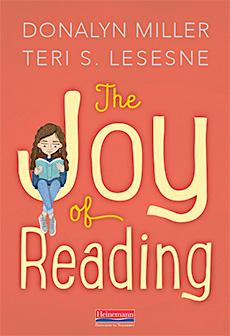Recapturing the Joy of Reading for Students
The Joy of Reading
By Donalyn Miller and Teri Lesesne
(Heinemann, 2022 – Learn more)
Reviewed by Cheryl Mizerny

I required my students to answer chapter questions, write definitions to vocabulary words, complete book reports, and take tests at the end. I even tried to add a “fun” final project in the mix, but they were never that valuable.
I wasn’t loving it and neither were the children.

A few years later, I added books by Teri Lesesne to my professional library and incorporated her advice and techniques into my teaching as well. I’ve also had the pleasure to see Donalyn and Teri present together and separately many times, and I’ve always come away with some new knowledge or, at the very least, a renewed spark that makes me remember why I love this job so much.
Fast Forward to 2022
The last two years of teaching in person during a pandemic have been the most challenging of my 30-year career. Like many others, I have contemplated leaving the profession altogether. Sadly, even my ability to concentrate on one of my favorite activities – settling into a great novel – suffered.
I am grateful that The Joy of Reading has come along to remind me once again of what a love of books and reading adds to our lives as adults and as educators. In the words of Miller and Lesesne: “Here’s the truth: It is possible to teach children how to read well without killing their love for reading in the process.” (p. xvii)
Although I’ve tried to make my classroom as joyful as possible, there have been a lot of “those” days the last couple of years where I know this has not been the case. I needed the reminders in this book.
A Conversation to Transform Practice
If you have ever seen Donalyn and Teri speak in person or watched them on video, you know they are a dynamic duo. Both whip-smart, hilarious, and fiercely dedicated to sharing their knowledge and experience to better the profession. Because I am so familiar with their work and beliefs, in many ways this book felt like a revisit of their past work.
However, whereas many of their earlier books were theoretical in nature with tips to adopt into practice, The Joy of Reading feels like sitting in an auditorium hearing them share their ideas to transform the practice of those in attendance. Yes, it still contains the research to support their suggestions, but it feels more conversational in nature. Not only is the book very attractive and easy to read, but it also contains scores of practical strategies that can be implemented immediately as well as valuable resources to ensure success.
Rejecting Practices That Depress Joy
Chapter One – Joy, What Is It Good For? – presents the myriad ways that reading adds joy to our lives. Miller and Lesesne share how to write a reading autobiography and why it is important for us and our students. By reflecting on these early experiences, the authors hope for us to “identify moments of reading joy.” Our students’ reading autobiographies provide valuable information that allows the teacher to begin building the foundation of a community of readers.
In the section “What’s at Stake When We Lose Reading Joy,” Miller and Lesesne speak to the destruction of reading for pleasure in our current data-driven education systems where reading is primarily associated with rigor, accountability, incentives, and grades.
They provide research about what we lose when we destroy reading joy and shed light on how some common practices such as the warping of the intent of Miller’s own “40 Book Challenge” have made reading one of the least enjoyable practices in a child’s day.
They provide a blueprint for avoiding these practices and what to do instead. This research should be enough to convince any administrator to want to promote the reading habit in classrooms.
Enlivening Methods That Work
The remaining chapters reinforce the methods that Miller and Lesesne have long championed – giving time and access, honoring choice, allowing for authentic response, and developing a community of readers.
Although they have both written about these topics before, this book is different. They have utilized their combined wisdom and experience to not only tell the reader why these things are important, they have included practical tips on how to achieve them quickly. This is where the book will be invaluable to teachers wanting to recapture reading joy in their classrooms.
In considering providing abundant time and access, Donalyn and Teri share advice and resources for how to find books for a classroom library, get books into students’ hands from the public library, and procure books that students can keep at home for their very own. Chapter Three speaks to how choice is the strongest motivator. The authors share how some school practices and beliefs limit choice and then give ideas on how to match the reader to a “just right” book.
Alternatives to Task-driven Assignments
In Chapter Four they discuss how readers respond to a text authentically instead of for accountability. The authors examine how task-focused reading destroys motivation to read for pleasure, but also what can be done as alternatives. This chapter ends with a beautiful description of what a classroom that values aesthetic response can look like. It reads almost like a design guide for “creating a culture where students feel free to respond and inspires them to interact with books and other readers as they wish.” (p. 141)
Finally, Chapter Five shares many techniques for establishing routines and rituals to create a strong, joyful reading community. The appendices offer a multitude of resources such as websites, creators, book sources, and activities that are alone worth the cost of the book.
The Joy of Reading comes along as the year is ending and I am exhausted, but in reading it, I am newly invigorated to finish the year strong and reinforced that in my classroom we are all readers, and we can always find joy in that!
Read another review of The Joy of Reading
Cheryl Mizerny (@cherylteaches) is a veteran educator with 25 years experience – most at the middle school level. She began her career in special education, became a teacher consultant and adjunct professor of Educational Psychology, and currently teaches 6th grade English in Bloomfield Hills, Michigan. Read her rich collection of MiddleWeb articles here.



































My copy is on order, and after reading your review, I’m even more eager to receive and read it! Thanks.